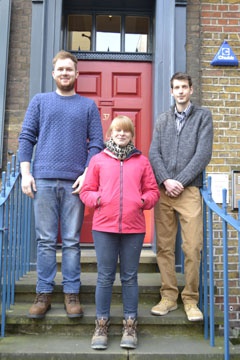Stone conservator Emma joins SPAB Fellows
Stone conservator Emma Teale joins blacksmith Joe Coombes-Jackman and carpenter Ben Hornberger as this year's William Morris Craft Fellows.
Emma is 36 with a BA(Hons) in History of Art. She began working voluntarily with the National Trust. She worked at Hampton Court Palace before moving to Oxburgh Hall as an assistant house steward for three years. She joined the conservation department at Rattee & Kett in Cambridge as a trainee, where she attended various courses to improve her skills.
Emma then went on to spend nine years at Skillington Workshop Ltd in Grantham, where she continued to develop. She has experience in Doff, Torc and laser stone cleaning techniques, as well as stone and monument conservation, plaster conservation and decorative arts work. She most recently worked on renovation of the 19th century mosaics at St George’s Church, Woolwich. She is keen to explore the architectural side of the industry and also hopes to learn more about brickwork, metalwork and glazing.
The William Morris Craft Felllowship is run by the Society for the Protection of Ancient Buildings (SPAB) and each year gives usually three but sometimes four craftspeople the opportunity to further their education in the skills needed to look after the UK's built heritage. The latest talented trio have now begun their countrywide conservation ‘grand tour’. Being part of the Fellowship is a significant boost to any CV.
Since 1987, SPAB has organised the Fellowship to foster a new generation of outstanding craftspeople with the knowledge and expertise to pass on essential skills for working with historic materials. The prestigious scheme runs in parallel to SPAB’s Scholarship programme for architectural / building professionals.
The aim is for the Fellows to gain broad, practical experience and knowledge to enable them to bring a strong awareness of craft diversity to their future professional roles. The Fellowship also equips them with the skills necessary to lead and manage historic building contracts, while deepening their understanding of the importance of gentle repair – the keystone of the SPAB conservation approach.
This month (March), the 2015 Fellows (and Scholars) set out on their six-month itinerary of site, workshop and studio visits. They are starting with a week in London visiting Hampton Court Palace and the Tower of London. Part of what they can look forward to is lead welding with Norman & Underwood, the lead-casters who made the King Richard III ossuary, and an introduction to milling at Charlecote Mill in Warwick.
In the coming months their travels will take them to significant conservation projects, workshops and studios in all parts of the country. They will learn about traditional building techniques from skilled craftsmen and women who have established careers in the field. You can follow their progress on SPAB’s blog dedicated to Fellows and Scholars, spabscholarsandfellows.wordpress.com.
Interest in craft building skills is steadily increasing as people turn to more sustainable and traditional methods of construction. Yet, ironically, these same skills are under threat as fewer young people are encouraged to pursue careers in these areas.
Nationally, heritage bodies are concerned that there are simply not enough people training to continue Britain’s distinctive buildings crafts. That makes SPAB’s Fellowship more relevant every year.
Three or four Fellowships are awarded each year depending on available funding. As usual, the SPAB’s 2015 Fellows are a committed and talented group with each individual looking to enhance a particular skill and further their knowledge of traditional craft techniques.
The Fellowship
Craftspeople from any trade employed in the repair of historic buildings on site or in workshops and studios may apply to join the Fellowship. Candidates must have completed their apprenticeships and be able to demonstrate a high degree of competence.
Fellows will have the opportunity to develop their own particular craft skill to new levels of excellence. The course of practical training is divided into three blocks of two months, enabling the Fellows to return to their employment in between each block.
During the first two blocks, the Fellows travel in their group. They make daily site visits, study repair projects and meet professionals, contractors and craftsmen. On site they experience craftsmanship first-hand and discuss traditional building construction and techniques.
The final block of training is devoted to the individual needs and interests of each fellow in consultation with their employers. The programme runs from mid-March to December. There are no course fees as training and administration costs are borne by SPAB as part of the award.
Many former fellows have risen to positions of responsibility where they are able to impart their knowledge, expertise and enthusiasm to other craft workers.
The SPAB William Morris Craft Fellowship is helping to raise the standard of building conservation skills and the skills of the craftsmen and women involved.
For more information visit the SPAB website.
SPAB would like to thank the following organisations for their generous support:
- Historic England
- William Morris Craft Fellowship Trust
- William Morris Society
- Drake Trust
- Historic Scotland
- Carpenters’ Company Charitable Trust
- Carrington (1953) Ltd
- Norman & Underwood
The Society for the Protection of Ancient Buildings (SPAB) was founded by William Morris 125 years ago to care for and preserve the UK’s architectural heritage. Since its foundation, SPAB has been committed to maintenance matters, in line with William Morris’ exhortation to: “Stave off decay by daily care.” Today SPAB is a dynamic organisation, and registered charity (No 231307), taking building conservation into the future.

